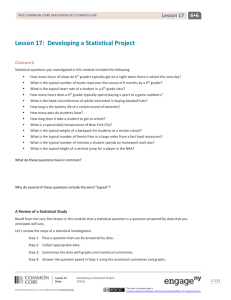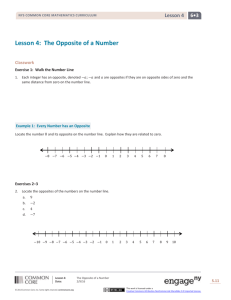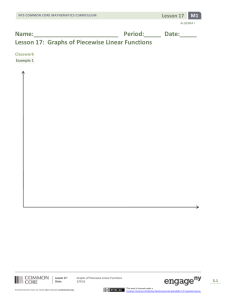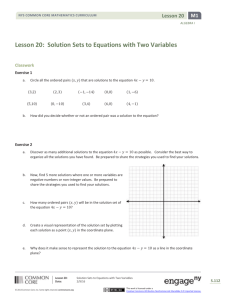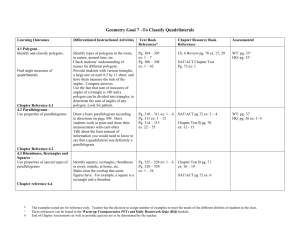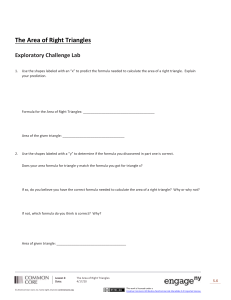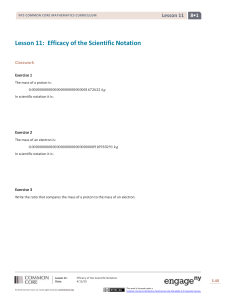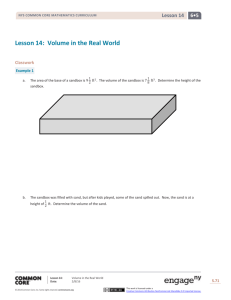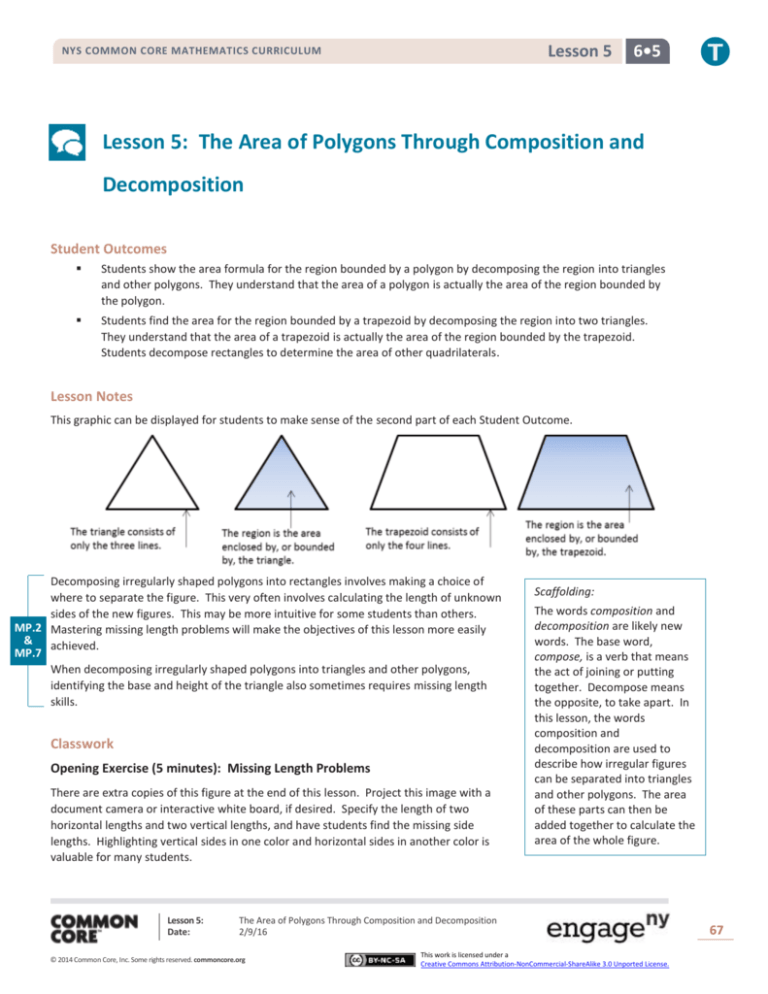
Lesson 5
NYS COMMON CORE MATHEMATICS CURRICULUM
6•5
Lesson 5: The Area of Polygons Through Composition and
Decomposition
Student Outcomes
Students show the area formula for the region bounded by a polygon by decomposing the region into triangles
and other polygons. They understand that the area of a polygon is actually the area of the region bounded by
the polygon.
Students find the area for the region bounded by a trapezoid by decomposing the region into two triangles.
They understand that the area of a trapezoid is actually the area of the region bounded by the trapezoid.
Students decompose rectangles to determine the area of other quadrilaterals.
Lesson Notes
This graphic can be displayed for students to make sense of the second part of each Student Outcome.
Decomposing irregularly shaped polygons into rectangles involves making a choice of
where to separate the figure. This very often involves calculating the length of unknown
sides of the new figures. This may be more intuitive for some students than others.
MP.2 Mastering missing length problems will make the objectives of this lesson more easily
& achieved.
MP.7
When decomposing irregularly shaped polygons into triangles and other polygons,
identifying the base and height of the triangle also sometimes requires missing length
skills.
Classwork
Opening Exercise (5 minutes): Missing Length Problems
There are extra copies of this figure at the end of this lesson. Project this image with a
document camera or interactive white board, if desired. Specify the length of two
horizontal lengths and two vertical lengths, and have students find the missing side
lengths. Highlighting vertical sides in one color and horizontal sides in another color is
valuable for many students.
Lesson 5:
Date:
Scaffolding:
The words composition and
decomposition are likely new
words. The base word,
compose, is a verb that means
the act of joining or putting
together. Decompose means
the opposite, to take apart. In
this lesson, the words
composition and
decomposition are used to
describe how irregular figures
can be separated into triangles
and other polygons. The area
of these parts can then be
added together to calculate the
area of the whole figure.
The Area of Polygons Through Composition and Decomposition
2/9/16
© 2014 Common Core, Inc. Some rights reserved. commoncore.org
This work is licensed under a
Creative Commons Attribution-NonCommercial-ShareAlike 3.0 Unported License.
67
Lesson 5
NYS COMMON CORE MATHEMATICS CURRICULUM
6•5
Opening Exercise
Here is an aerial view of a woodlot.
A
F
B
E
D
C
If 𝑨𝑩 = 𝟏𝟎 units, 𝑭𝑬 = 𝟖 units, 𝑨𝑭 = 𝟔 units, and 𝑫𝑬 = 𝟕 units, find the lengths of both other sides.
𝑫𝑪 = 𝟐 units
𝑩𝑪 = 𝟏𝟑 units
Scaffolding:
If 𝑫𝑪 = 𝟏𝟎 units, 𝑭𝑬 = 𝟑𝟎 units, 𝑨𝑭 = 𝟐𝟖 units, and 𝑩𝑪 = 𝟓𝟒 units, find the lengths of
both other sides.
𝑨𝑩 = 𝟒𝟎 units
𝑫𝑬 = 𝟐𝟔 units
Lesson 5:
Date:
If students have difficulty seeing these
relationships, it can be helpful to show
progressions of figures, such as those
below, which move gradually from the
sides of a rectangle to an irregular
rectilinear figure. Consistent use of
visuals, as well as manipulatives, such as
cut-outs of these figures, will aid in
understanding.
The Area of Polygons Through Composition and Decomposition
2/9/16
© 2014 Common Core, Inc. Some rights reserved. commoncore.org
This work is licensed under a
Creative Commons Attribution-NonCommercial-ShareAlike 3.0 Unported License.
68
Lesson 5
NYS COMMON CORE MATHEMATICS CURRICULUM
6•5
Discussion (5 minutes)
If students are struggling to see this relationship, it might be helpful for them to complete the rectangle that encloses
the figure:
How do you know which operation to use when finding missing side lengths?
If we know two short sides (vertical or horizontal), we add to find the longer side.
If we know the long side and one short side (vertical or horizontal), we subtract.
These examples used whole numbers for the lengths of the sides. What would you do if there were decimal
lengths?
MP.7
Would the process be the same for deciding whether to add or subtract?
One critical step is making sure you add and subtract numbers that have the same place value by lining
up the decimal points.
What if the lengths were given as fractions or mixed numbers?
Yes.
When adding or subtracting decimals, what is one step that is critical to arriving at the correct answer?
We would add or subtract the decimal numbers.
We would add or subtract the fractions or the mixed numbers.
Would the process be the same for deciding whether to add or subtract?
Yes.
Ask students to find the next diagram on their classwork page. Work through the scenario with them. The area of this
figure can be found in at least three ways: using two horizontal cuts, using two vertical cuts, or subtracting the missing
area from the larger rectangle (using overall length and width). There is a drawing included at the end of this lesson that
has the grid line inserted.
Lesson 5:
Date:
The Area of Polygons Through Composition and Decomposition
2/9/16
© 2014 Common Core, Inc. Some rights reserved. commoncore.org
This work is licensed under a
Creative Commons Attribution-NonCommercial-ShareAlike 3.0 Unported License.
69
Lesson 5
NYS COMMON CORE MATHEMATICS CURRICULUM
6•5
𝟐𝐦
𝟐𝐦
𝟒𝐦
𝟗𝐦
𝟕𝐦
MP.1
How could we determine the total area?
Let’s divide the figure using two horizontal lines. Will that make any rectangles
with two known sides?
No, the entire 7 m side cannot be used. Part has been removed, two 2 m segments, leaving only 3 m.
2 m by 9 m, 2 m by 9 m, and 3 m by 5 m
Calculate and mark each of these areas.
Yes, it makes two 2 by 9 rectangles.
What are the dimensions of the three resulting rectangles?
51 m2
Can we then use this 7 m measure directly? Why or why not?
2 m × 4 m = 8 m2 , 2 m × 4 m = 8 m2 , 7 m × 5 m = 35 m2
Divide the next figure using two vertical lines. Will that make any rectangles with two known sides?
2 m by 4 m, 2 m by 4 m, and 7 m by 5 m.
What is the total area of the figure?
Some students will benefit
from actually cutting the
irregularly shaped polygons
before marking the dimensions
on the student pages. If
needed, there are reproducible
copies included at the end of
the lesson.
Calculate and mark each of these areas.
The entire 9 m side cannot be used. Part has been removed, 4 m, leaving
only 5 m. We use subtraction.
Scaffolding:
What are the dimensions of the three resulting rectangles?
No. The 9 m includes the top part of the figure, but we have already
found the dimensions of this part.
What is the height of that third rectangle and how do you find it?
Yes, it makes two 2 by 4 rectangles.
Can we then use this 9 m measure directly? Why or why not?
Using two horizontal lines, two vertical lines, or one of each.
2 m × 9 m = 18 m2 , 2 m × 9 m = 18 m2 , 3 m × 5 m = 15 m2
What is the total area of the figure?
51 m2
Lesson 5:
Date:
The Area of Polygons Through Composition and Decomposition
2/9/16
© 2014 Common Core, Inc. Some rights reserved. commoncore.org
This work is licensed under a
Creative Commons Attribution-NonCommercial-ShareAlike 3.0 Unported License.
70
Lesson 5
NYS COMMON CORE MATHEMATICS CURRICULUM
Divide the last figure using one vertical line and one horizontal line. Are there missing sides to calculate?
MP.2
6•5
Yes, both sides of the 5 by 5 rectangle had to be found by decomposing the other measures.
What are the dimensions of the three resulting rectangles?
2 m by 9 m, 2 m by 4 m, and 5 m by 5 m
Calculate and mark each of these areas.
2 m × 9 m = 18 m2 , 2 m × 4 m = 8 m2 , 5 m × 5 m = 25 m2
What is the total area of the figure?
51 m2
Finally, if we look at this as a large rectangle with a piece removed, what are the dimensions of the large
rectangle?
9 m by 7 m
What are the dimensions of the missing piece that looks like it was cut out?
3 m by 4 m
Calculate these two areas.
9 m × 7 m = 63 m2 , 3 m × 4 m = 12 m2
How can we use these two areas to find the area of the original figure?
Subtract the smaller area from the larger one.
What is the difference between 63 m2 and 12 m2 ?
63 m2 − 12 m2 = 51 m2
Is there an advantage to one of these methods over the others?
Answers will vary. In this example, either one or two calculations are necessary when decomposing the
figure.
Consider the two expressions: 18 m2 + 8 m2 + 25 m2 and 63 m2 − 12 m2 .
What do the terms in these expressions represent in this problem?
The first is a “sum of the parts” expression, and the second is a “whole minus part” expression. More
specifically, the first expression shows that the total area is the sum of the areas of three rectangles;
the second expression shows that the total area is the area of a large rectangle minus the area of a
small one.
Allow some time for discussion before moving on.
Example 1 (10 minutes): Decomposing Polygons into Rectangles
Example 1: Decomposing Polygons into Rectangles
The Intermediate School is producing a play that needs a special stage built. A diagram is shown below (not to scale).
a.
On the first diagram, divide the stage into three rectangles using two horizontal lines. Find the dimensions of
these rectangles and calculate the area of each. Then, find the total area of the stage.
Dimensions: 𝟐 𝐦 by 𝟒 𝐦, 𝟐 𝐦 by 𝟒 𝐦, and 𝟕 𝐦 by 𝟓 𝐦
Area: 𝟐 𝐦 × 𝟒 𝐦 = 𝟖 𝐦𝟐, 𝟐 𝐦 × 𝟒 𝐦 = 𝟖 𝐦𝟐, 𝟕 𝐦 × 𝟓 𝐦 = 𝟑𝟓 𝐦𝟐
Total: 𝟖 𝐦𝟐 + 𝟖 𝐦𝟐 + 𝟑𝟓 𝐦𝟐 = 𝟓𝟏 𝐦𝟐
Lesson 5:
Date:
The Area of Polygons Through Composition and Decomposition
2/9/16
© 2014 Common Core, Inc. Some rights reserved. commoncore.org
This work is licensed under a
Creative Commons Attribution-NonCommercial-ShareAlike 3.0 Unported License.
71
Lesson 5
NYS COMMON CORE MATHEMATICS CURRICULUM
b.
6•5
On the second diagram, divide the stage into three rectangles using two vertical lines. Find the dimensions of
these rectangles and calculate the area of each. Then, find the total area of the stage.
Dimensions: 𝟐 𝐦 by 𝟗 𝐦, 𝟐 𝐦 by 𝟗 𝐦, and 𝟑 𝐦 by 𝟓 𝐦
Area: 𝟐 𝐦 × 𝟗 𝐦 = 𝟏𝟖 𝐦𝟐, 𝟐 𝐦 × 𝟗 𝐦 = 𝟏𝟖 𝐦𝟐, 𝟑 𝐦 × 𝟓 𝐦 = 𝟏𝟓 𝐦𝟐
Total: 𝟓𝟏 𝐦𝟐
c.
On the third diagram, divide the stage into three rectangles using one horizontal line and one vertical line.
Find the dimensions of these rectangles and calculate the area of each. Then, find the total area of the stage.
Dimensions: 𝟐 𝐦 by 𝟗 𝐦, 𝟐 m by 𝟒 𝐦, and 𝟓 𝐦 by 𝟓 𝐦
Area: 𝟐 𝐦 × 𝟗 𝐦 = 𝟏𝟖 𝐦𝟐, 𝟐 𝐦 × 𝟒 𝐦 = 𝟖 𝐦𝟐, 𝟓 𝐦 × 𝟓 𝐦 = 𝟐𝟓 𝐦𝟐
Total: 𝟓𝟏 𝐦𝟐
𝟐𝐦
𝟐𝐦
𝟐𝐦
𝟒𝐦
𝟐𝐦
𝟒𝐦
𝟕𝐦
𝟐𝐦
𝟒𝐦
𝟗𝐦
𝟗𝐦
d.
𝟐𝐦
𝟗𝐦
𝟕𝐦
𝟕𝐦
Think of this as a large rectangle with a piece removed.
i.
What are the dimensions of the large rectangle and the small rectangle?
Dimensions: 𝟗 𝐦 by 𝟕 𝐦 and 𝟑 𝐦 by 𝟒 𝐦
ii.
What are the areas of the two rectangles?
Area: 𝟗 𝐦 × 𝟕 𝐦 = 𝟔𝟑 𝐦𝟐 , 𝟑 𝐦 × 𝟒 𝐦 = 𝟏𝟐 𝐦𝟐
iii.
What operation is needed to find the area of the original figure?
Subtraction
iv.
What is the difference in area between the two rectangles?
𝟔𝟑 𝐦𝟐 − 𝟏𝟐 𝐦𝟐 = 𝟓𝟏 𝐦𝟐
v.
What do you notice about your answers to (a), (b), (c), and (d)?
The area is the same.
vi.
Why do you think this is true?
No matter how we decompose the figure, the total area is the sum of its parts. Even if we take the area
around the figure and subtract the part that is not included, the area of the figure remains the same,
𝟓𝟏 𝐦𝟐.
Lesson 5:
Date:
The Area of Polygons Through Composition and Decomposition
2/9/16
© 2014 Common Core, Inc. Some rights reserved. commoncore.org
This work is licensed under a
Creative Commons Attribution-NonCommercial-ShareAlike 3.0 Unported License.
72
Lesson 5
NYS COMMON CORE MATHEMATICS CURRICULUM
6•5
Scaffolding:
1
As an extension, ask students
to manipulate these unsimplified numerical
expressions to demonstrate
equivalence of areas (MP.2).
2
3
1
For example, using the factors
of the area, showing that
2×4+2×4+7×5=
2×9+2×9+3×5
by applying the distributive
property and using
decomposition of whole
numbers.
2
3
Using the products (areas), the
equivalence should be made
clear:
8 + 8 + 35 = 18 + 18 + 15
= 63 − 12
Example 2 (10 minutes): Decomposing Polygons into Rectangles and Triangles
In this example, a parallelogram is bisected along a diagonal. The resulting triangles are congruent, with the same base
and height of the parallelogram. Students should see that the area for a parallelogram is equal to the base times the
height, regardless of how much the bases are skewed. Ask how we could find the area using only triangles.
Scaffolding:
Example 2: Decomposing Polygons into Rectangles and Triangles
Parallelogram 𝑨𝑩𝑪𝑫 is part of a large solar power collector. The base measures 𝟔 𝐦 and the
height is 𝟒 𝐦.
a.
Some students will benefit
from actually cutting the
parallelograms from paper to
prove their congruency. There
are reproducible copies
included.
Draw a diagonal from 𝑨 to 𝑪. Find the area of both triangles 𝑨𝑩𝑪 and 𝑨𝑪𝑫.
Student drawing and calculations are shown here.
Lesson 5:
Date:
△ 𝑨𝑩𝑪
𝟏
𝑨 = 𝒃𝒉
𝟐
𝟏
𝑨 = (𝟔 𝐦)(𝟒 𝐦)
𝟐
𝑨 = 𝟏𝟐 𝐦𝟐
△ 𝑨𝑪𝑫
𝟏
𝑨 = 𝒃𝒉
𝟐
𝟏
𝑨 = (𝟔 𝐦)(𝟒 𝐦)
𝟐
𝑨 = 𝟏𝟐 𝐦𝟐
The Area of Polygons Through Composition and Decomposition
2/9/16
© 2014 Common Core, Inc. Some rights reserved. commoncore.org
This work is licensed under a
Creative Commons Attribution-NonCommercial-ShareAlike 3.0 Unported License.
73
Lesson 5
NYS COMMON CORE MATHEMATICS CURRICULUM
What is the area of each triangle?
12 m2
6•5
What is the area of the parallelogram?
24 m2
b.
Draw in the other diagonal, from 𝑩 to 𝑫. Find the area of both triangles 𝑨𝑩𝑫 and 𝑩𝑪𝑫.
Student drawing and calculations are shown here.
△ 𝑨𝑩𝑫
𝟏
𝑨 = 𝒃𝒉
𝟐
𝟏
𝑨 = (𝟔 𝐦)(𝟒 𝐦)
𝟐
𝑨 = 𝟏𝟐 𝐦𝟐
△ 𝑩𝑪𝑫
𝟏
𝑨 = 𝒃𝒉
𝟐
𝟏
𝑨 = (𝟔 𝒎)(𝟒 𝒎)
𝟐
𝑨 = 𝟏𝟐 𝒎𝟐
Example 3 (10 minutes): Decomposing Trapezoids
Drawing one of the diagonals in a trapezoid separates the figure into two non-congruent triangles. Note that the height
of these triangles is the same if the two bases of the trapezoid are used as bases of the triangles. If students want to
consider the area of the rectangle around the trapezoid, two exterior right triangles will be formed. For isosceles
trapezoids, these triangles will be congruent. For scalene trapezoids, two non-congruent triangles will result. A
reproducible copy of trapezoids is included at the end of this lesson for use in further investigation. In all cases, the area
can be found by averaging the length of the bases and multiplying by the height.
What is the area of the garden plot? Use what you know about decomposing and composing to determine the
area.
Example 3: Decomposing Trapezoids
The trapezoid below is a scale drawing of a garden plot.
If students need prompting, ask them to draw a diagonal from 𝐴 to 𝐶.
Lesson 5:
Date:
The Area of Polygons Through Composition and Decomposition
2/9/16
© 2014 Common Core, Inc. Some rights reserved. commoncore.org
This work is licensed under a
Creative Commons Attribution-NonCommercial-ShareAlike 3.0 Unported License.
74
Lesson 5
NYS COMMON CORE MATHEMATICS CURRICULUM
6•5
Find the area of both triangles 𝑨𝑩𝑪 and 𝑨𝑪𝑫. Then find the area of the trapezoid.
Student drawing and calculations are shown here.
△ 𝑨𝑩𝑪
𝟏
𝑨 = 𝒃𝒉
𝟐
𝟏
𝑨 = (𝟖 𝐦)(𝟓 𝐦)
𝟐
𝑨 = 𝟐𝟎 𝐦𝟐
△ 𝑨𝑪𝑫
𝟏
𝑨 = 𝒃𝒉
𝟐
𝟏
𝑨 = (𝟒 𝐦)(𝟓 𝐦)
𝟐
𝑨 = 𝟏𝟎 𝐦𝟐
𝑨 = 𝟐𝟎 𝐦𝟐 + 𝟏𝟎 𝐦𝟐 = 𝟑𝟎 𝐦𝟐
If necessary, further prompt students to draw in the other diagonal, from 𝐵 to 𝐷.
Find the area of both triangles 𝑨𝑩𝑫 and 𝑩𝑪𝑫. Then find the area of the trapezoid.
Student drawing and calculations are shown here.
△ 𝑨𝑩𝑫
𝟏
𝑨 = 𝒃𝒉
𝟐
𝟏
𝑨 = (𝟖 𝐦)(𝟓 𝐦)
𝟐
𝑨 = 𝟐𝟎 𝐦𝟐
△ 𝑩𝑪𝑫
𝟏
𝑨 = 𝒃𝒉
𝟐
𝟏
𝑨 = (𝟒 𝐦)(𝟓 𝐦)
𝟐
𝑨 = 𝟏𝟎 𝐦𝟐
𝑨 = 𝟐𝟎 𝐦𝟐 + 𝟏𝟎 𝐦𝟐 = 𝟑𝟎 𝐦𝟐
How else could we find this area?
We could consider the rectangle that surrounds the trapezoid. Find the area of that rectangle, and then subtract the area
of both right triangles.
Student drawing and calculations are shown here.
Area of Rectangle
𝑨 = 𝒃𝒉
𝑨 = 𝟖𝐦×𝟓𝐦
𝑨 = 𝟒𝟎 𝐦𝟐
△𝟏
𝟏
𝑨 = 𝒃𝒉
𝟐
𝟏
𝑨 = (𝟑 𝐦)(𝟓 𝐦)
𝟐
𝑨 = 𝟕. 𝟓 𝐦𝟐
△𝟐
𝟏
𝑨 = 𝒃𝒉
𝟐
𝟏
𝑨 = (𝟏 𝐦)(𝟓 𝐦)
𝟐
𝑨 = 𝟐. 𝟓 𝐦𝟐
𝑨 = 𝟒𝟎 𝐦𝟐 − 𝟕. 𝟓 𝐦𝟐 − 𝟐. 𝟓 𝐦𝟐 = 𝟑𝟎 𝐦𝟐
OR
𝑨 = 𝟒𝟎 𝐦𝟐 − (𝟕. 𝟓 𝐦𝟐 + 𝟐. 𝟓 𝐦𝟐 ) = 𝟑𝟎 𝐦𝟐
Lesson 5:
Date:
The Area of Polygons Through Composition and Decomposition
2/9/16
© 2014 Common Core, Inc. Some rights reserved. commoncore.org
This work is licensed under a
Creative Commons Attribution-NonCommercial-ShareAlike 3.0 Unported License.
75
Lesson 5
NYS COMMON CORE MATHEMATICS CURRICULUM
6•5
Closing (2 minutes)
How can we find the area of irregularly shaped polygons?
They can be broken into rectangles and triangles; we can then calculate the area of the figure using the
formulas we already know.
Which operations did we use today to find the area of our irregular polygons?
Some methods used addition of the area of the parts. Others used subtraction from a surrounding
rectangle.
Exit Ticket (3 minutes)
Lesson 5:
Date:
The Area of Polygons Through Composition and Decomposition
2/9/16
© 2014 Common Core, Inc. Some rights reserved. commoncore.org
This work is licensed under a
Creative Commons Attribution-NonCommercial-ShareAlike 3.0 Unported License.
76
Lesson 5
NYS COMMON CORE MATHEMATICS CURRICULUM
Name ___________________________________________________
6•5
Date____________________
Lesson 5: The Area of Polygons Through Composition and
Decomposition
Exit Ticket
1.
Find the missing dimensions of the figure below, and then find the area. The figure is not drawn to scale.
2.
Find the area of the parallelogram below. The figure is not drawn to scale.
Lesson 5:
Date:
The Area of Polygons Through Composition and Decomposition
2/9/16
© 2014 Common Core, Inc. Some rights reserved. commoncore.org
This work is licensed under a
Creative Commons Attribution-NonCommercial-ShareAlike 3.0 Unported License.
77
Lesson 5
NYS COMMON CORE MATHEMATICS CURRICULUM
6•5
Exit Ticket Sample Solutions
1.
Find the missing dimensions of the figure below, and then find the area. The figure is not drawn to scale.
Solutions can be any of the below.
2.
Find the area of the parallelogram below. The figure is not drawn to scale.
8 mi.
𝐀𝐫𝐞𝐚 𝐨𝐟 𝐓𝐫𝐢𝐚𝐧𝐠𝐥𝐞 𝟏
𝐀𝐫𝐞𝐚 𝐨𝐟 𝐓𝐫𝐢𝐚𝐧𝐠𝐥𝐞 𝟐
𝟏
𝒃𝒉
𝟐
𝟏
𝑨 = × 𝟖 𝐦𝐢. × 𝟏𝟎 𝐦𝐢.
𝟐
𝟏
𝒃𝒉
𝟐
𝟏
𝑨 = × 𝟖 𝐦𝐢. × 𝟏𝟎 𝐦𝐢.
𝟐
𝑨=
𝑨=
𝑨 = 𝟒𝟎 𝐦𝐢𝟐
𝑨 = 𝟒𝟎 𝐦𝐢𝟐
𝐀𝐫𝐞𝐚 𝐨𝐟 𝐏𝐚𝐫𝐚𝐥𝐥𝐞𝐥𝐨𝐠𝐫𝐚𝐦 = 𝐀𝐫𝐞𝐚 𝐨𝐟 𝐓𝐫𝐢𝐚𝐧𝐠𝐥𝐞 𝟏 + 𝐀𝐫𝐞𝐚 𝐨𝐟 𝐓𝐫𝐢𝐚𝐧𝐠𝐥𝐞 𝟐
𝑨 = 𝟒𝟎 𝐦𝐢𝟐 + 𝟒𝟎 𝐦𝐢𝟐 = 𝟗𝟎 𝐦𝐢𝟐
The area of the parallelogram is 𝟖𝟎 𝐦𝐢𝟐.
Lesson 5:
Date:
The Area of Polygons Through Composition and Decomposition
2/9/16
© 2014 Common Core, Inc. Some rights reserved. commoncore.org
This work is licensed under a
Creative Commons Attribution-NonCommercial-ShareAlike 3.0 Unported License.
78
Lesson 5
NYS COMMON CORE MATHEMATICS CURRICULUM
6•5
Problem Set Sample Solutions
1.
If 𝑨𝑩 = 𝟐𝟎, 𝑭𝑬 = 𝟏𝟐, 𝑨𝑭 = 𝟗, and 𝑫𝑬 = 𝟏𝟐, find the length of both other sides. Then, find the area of the
irregular polygon.
𝑪𝑫 = 𝟖, 𝑩𝑪 = 𝟐𝟏, 𝐀𝐫𝐞𝐚 = 𝟐𝟕𝟔 𝐮𝐧𝐢𝐭𝐬 𝟐
2.
If 𝑫𝑪 = 𝟏. 𝟗 𝐜𝐦, 𝑭𝑬 = 𝟓. 𝟔 𝐜𝐦, 𝑨𝑭 = 𝟒. 𝟖 𝐜𝐦, and 𝑩𝑪 = 𝟏𝟎. 𝟗 𝐜𝐦, find the length of both other sides. Then, find
the area of the irregular polygon.
𝑨𝑩 = 𝟕. 𝟓 𝐜𝐦, 𝑫𝑬 = 𝟔. 𝟏 𝐜𝐦, 𝐀𝐫𝐞𝐚 = 𝟒𝟕. 𝟓𝟗 𝐜𝐦𝟐
3.
Determine the area of the trapezoid below. The trapezoid is not drawn to scale.
Area of Triangle 1
Area of Triangle 2
𝟏
𝒃𝒉
𝟐
𝟏
𝑨 = × 𝟐𝟐 𝐦 × 𝟏𝟖 𝐦
𝟐
𝟏
𝒃𝒉
𝟐
𝟏
𝑨 = × 𝟑 𝐦 × 𝟏𝟖 𝐦
𝟐
𝑨=
𝑨=
𝑨 = 𝟏𝟗𝟖 𝐦𝟐
𝑨 = 𝟐𝟕 𝐦𝟐
𝐀𝐫𝐞𝐚 𝐨𝐟 𝐓𝐫𝐚𝐩𝐞𝐳𝐨𝐢𝐝 = 𝐀𝐫𝐞𝐚 𝐨𝐟 𝐓𝐫𝐢𝐚𝐧𝐠𝐥𝐞 𝟏 + 𝐀𝐫𝐞𝐚 𝐨𝐟 𝐓𝐫𝐢𝐚𝐧𝐠𝐥𝐞 𝟐
𝐀𝐫𝐞𝐚 = 𝟏𝟗𝟖 𝐦𝟐 + 𝟐𝟕 𝐦𝟐 = 𝟐𝟐𝟓 𝐦𝟐
Lesson 5:
Date:
The Area of Polygons Through Composition and Decomposition
2/9/16
© 2014 Common Core, Inc. Some rights reserved. commoncore.org
This work is licensed under a
Creative Commons Attribution-NonCommercial-ShareAlike 3.0 Unported License.
79
Lesson 5
NYS COMMON CORE MATHEMATICS CURRICULUM
4.
6•5
Determine the area of the isosceles trapezoid below. The image is not drawn to scale.
Area of Rectangle
𝑨 = 𝒃𝒉
𝑨 = 𝟏𝟖 𝐦 × 𝟏𝟐 𝐦
𝑨 = 𝟐𝟏𝟔 𝐦𝟐
Area of Triangles 1 and 2
𝟏
𝒃𝒉
𝟐
𝟏
𝑨 = × 𝟕. 𝟓 𝐦 × 𝟏𝟐 𝐦
𝟐
𝑨=
𝑨 = 𝟒𝟓 𝐦𝟐
𝐀𝐫𝐞𝐚 𝐨𝐟 𝐓𝐫𝐚𝐩𝐞𝐳𝐨𝐢𝐝 = 𝐀𝐫𝐞𝐚 𝐨𝐟 𝐑𝐞𝐜𝐭𝐚𝐧𝐠𝐥𝐞 − 𝐀𝐫𝐞𝐚 𝐨𝐟 𝐓𝐫𝐢𝐚𝐧𝐠𝐥𝐞 𝟏 − 𝐀𝐫𝐞𝐚 𝐨𝐟 𝐓𝐫𝐢𝐚𝐧𝐠𝐥𝐞 𝟐
𝑨 = 𝟐𝟏𝟔 𝐦𝟐 − 𝟒𝟓 𝐦𝟐 − 𝟒𝟓 𝐦𝟐 = 𝟏𝟐𝟔 𝐦𝟐
5.
Here is a sketch of a wall that needs to be painted:
a.
The windows and door will not be painted. Calculate the area of the wall that will be painted.
Whole wall: 𝟏𝟐 𝐟𝐭. × 𝟖 𝐟𝐭. = 𝟗𝟔 𝐟𝐭 𝟐
Window: 𝟐 𝐟𝐭.× 𝟐 𝐟𝐭. = 𝟒 𝐟𝐭 𝟐 There are two identical windows, 𝟒 𝐟𝐭 𝟐 × 𝟐 = 𝟖 𝐟𝐭 𝟐
Door: 𝟔 𝐟𝐭.× 𝟑 𝐟𝐭. = 𝟏𝟖 𝐟𝐭 𝟐
𝟗𝟔 𝐟𝐭 𝟐 − 𝟖 𝐟𝐭 𝟐 − 𝟏𝟖 𝐟𝐭 𝟐 = 𝟕𝟎 𝐟𝐭 𝟐
b.
If a quart of Extra-Thick Gooey Sparkle paint covers 𝟑𝟎 𝐟𝐭 𝟐, how many quarts must be purchased for the
painting job?
𝟕𝟎 ÷ 𝟑𝟎 = 𝟐
𝟏
𝟑
Therefore, 𝟑 quarts must be purchased.
Lesson 5:
Date:
The Area of Polygons Through Composition and Decomposition
2/9/16
© 2014 Common Core, Inc. Some rights reserved. commoncore.org
This work is licensed under a
Creative Commons Attribution-NonCommercial-ShareAlike 3.0 Unported License.
80
Lesson 5
NYS COMMON CORE MATHEMATICS CURRICULUM
6.
6•5
The figure below shows a floor plan of a new apartment. New carpeting has been ordered, which will cover the
living room and bedroom but not the kitchen or bathroom. Determine the carpeted area by composing or
decomposing in two different ways, and then explain why they are equivalent.
MP.7
Answers will vary. Sample student responses are shown.
Bedroom: 𝟏𝟓 𝐟𝐭. × 𝟐𝟓 𝐟𝐭. = 𝟑𝟕𝟓 𝐟𝐭 𝟐
Living room: 𝟑𝟓 𝐟𝐭. × 𝟐𝟎 𝐟𝐭. = 𝟕𝟎𝟎 𝐟𝐭 𝟐
Sum of bedroom and living room: 𝟑𝟕𝟓 𝐟𝐭 𝟐 + 𝟕𝟎𝟎 𝐟𝐭 𝟐 = 𝟏𝟎𝟕𝟓 𝐟𝐭 𝟐
Alternatively, the whole apartment is 𝟒𝟓 𝐟𝐭. × 𝟑𝟓 𝐟𝐭. = 𝟏𝟓𝟕𝟓 𝐟𝐭 𝟐
Subtracting the kitchen and bath (𝟑𝟎𝟎 𝐟𝐭 𝟐 and 𝟐𝟎𝟎 𝐟𝐭 𝟐) still gives 𝟏𝟎𝟕𝟓 𝐟𝐭 𝟐.
The two areas are equivalent because they both represent the area of the living room and bedroom.
Lesson 5:
Date:
The Area of Polygons Through Composition and Decomposition
2/9/16
© 2014 Common Core, Inc. Some rights reserved. commoncore.org
This work is licensed under a
Creative Commons Attribution-NonCommercial-ShareAlike 3.0 Unported License.
81
Lesson 5
NYS COMMON CORE MATHEMATICS CURRICULUM
Lesson 5:
Date:
6•5
The Area of Polygons Through Composition and Decomposition
2/9/16
© 2014 Common Core, Inc. Some rights reserved. commoncore.org
This work is licensed under a
Creative Commons Attribution-NonCommercial-ShareAlike 3.0 Unported License.
82
Lesson 5
NYS COMMON CORE MATHEMATICS CURRICULUM
A
B
F
F
E
D
C
A
B
F
D
B
E
D
A
F
E
Lesson 5:
Date:
A
C
6•5
C
B
E
D
C
The Area of Polygons Through Composition and Decomposition
2/9/16
© 2014 Common Core, Inc. Some rights reserved. commoncore.org
This work is licensed under a
Creative Commons Attribution-NonCommercial-ShareAlike 3.0 Unported License.
83
Lesson 5
NYS COMMON CORE MATHEMATICS CURRICULUM
Lesson 5:
Date:
6•5
The Area of Polygons Through Composition and Decomposition
2/9/16
© 2014 Common Core, Inc. Some rights reserved. commoncore.org
This work is licensed under a
Creative Commons Attribution-NonCommercial-ShareAlike 3.0 Unported License.
84
Lesson 5
NYS COMMON CORE MATHEMATICS CURRICULUM
Lesson 5:
Date:
6•5
The Area of Polygons Through Composition and Decomposition
2/9/16
© 2014 Common Core, Inc. Some rights reserved. commoncore.org
This work is licensed under a
Creative Commons Attribution-NonCommercial-ShareAlike 3.0 Unported License.
85
Lesson 5
NYS COMMON CORE MATHEMATICS CURRICULUM
6•5
Horizontal
V
e
r
t
i
c
a
l
Lesson 5:
Date:
The Area of Polygons Through Composition and Decomposition
2/9/16
© 2014 Common Core, Inc. Some rights reserved. commoncore.org
This work is licensed under a
Creative Commons Attribution-NonCommercial-ShareAlike 3.0 Unported License.
86

